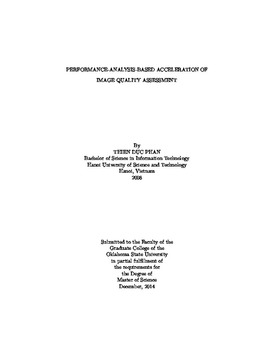| dc.description.abstract | Algorithms for image/video quality assessment (QA) aim to predict the qualitiesof images in a manner that agrees with subjective quality ratings. Over the lastseveral decades, the major impetus in QA research has focused on improving predictiveperformance; very few studies have focused on analyzing and improving theruntime performance of QA algorithms. Modern algorithms of image/video qualityassessment commonly employed two stages: (1) a local frequency-based decomposition, and (2) block-based statistical comparisons between the frequency coefficients of the reference and distorted images. These two stages constitute the bulk of the computation and runtime required for QA. This research thesis presents a performance analysis of and techniques for accelerating these stages. We also specifically analyze and accelerate one representative QA algorithm, Most Apparent Distortion (MAD), which was developed by Eric Larson and Damon Chandler in 2010 [1]. We identify the bottlenecks from the above-mentioned stages, and we present methods of acceleration using generalized integral image, inline expansion, a GPGPU implementation, and other code modifications. We show how a combination of these approaches can yield a speedup of 47x.The content of the report is divided into five different chapters. In Chapter 1,we present a general overview of QA algorithms, current work on improving the computational performance and execution time of QA algorithms, and an introduction toour work. In Chapter 2, we describe MAD algorithm, the first performance analysis,and the systems used to test the performance. In Chapter 3, we present generalizedintegral image and inline expansion techniques. In this chapter, we also providethe results of each technique in terms of speeding up running time. Chapter 4 providesGPGPU and some other code optimization techniques with the timing results.Finally, the conclusion are proposed in the Chapter 5 to summarize the report. | |
